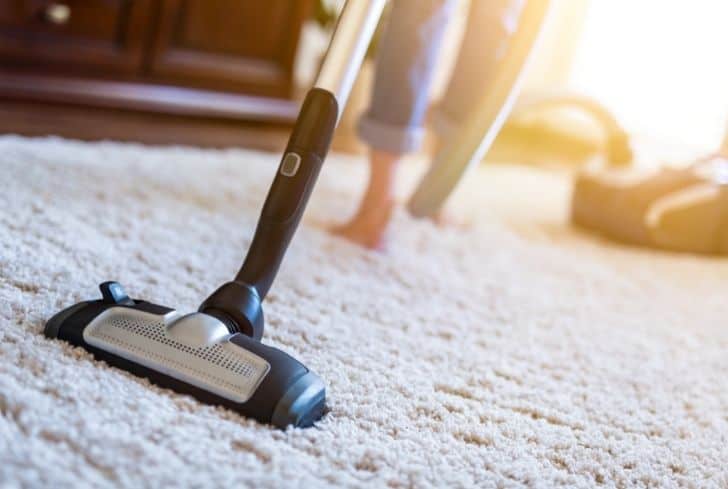We all love keeping our homes speckless at all times. However, let’s face it — cleaning our homes regularly isn’t a favorite chore for the best of us. But thanks to the invention of vacuum cleaners, the once dreaded task has been simplified and made fun.
But before you bring in a vacuum cleaner, know the impact it will have on your monthly utility bills. After all, as an appliance, a vacuum cleaner needs electricity to get the job done.
That said, just how many amps and watts does a vacuum cleaner use?
Well, that’s what we’ve lined up for you in this article. Here, we take an in-depth look into the energy consumption of vacuum cleaners. We’ll even narrow down to specific models, so stick around.
How Many Amps Does a Vacuum Cleaner Use?
The number of amps that a vacuum cleaner uses typically ranges from an amp to 15 amps at 120 volts. The difference in amperage depends on various factors, like the design of the vacuum cleaner and model, but most cleaners have an amperage of about 12 amps.
Understanding the amperage of an appliance is important for electrical safety and ensuring that the electrical circuitry in your home can support the appliance’s power requirements without overloading.
But just before we dive any deeper into today’s subject, let’s begin by understanding what we mean by amperage.
So, what are amps?
Well, when we talk about amps, it’s simply a measure of the current flow in an electrical circuit. In other words, the amperage of a vacuum cleaner is simply the amount of electrical current it requires to operate effectively.
It is different from wattage, which refers to the amount of power a unit consumes when running. It’s a measure of how much energy the appliance uses per unit of time and is typically measured in watts (W).
The amperage and wattage of an appliance differ but are closely related. They’re also different from voltage, which is the force that pushes electric charges (such as electrons) through a conductor, creating an electric current. Voltage is typically measured in volts (V).
Now, the three elements are related, so you can calculate either with the knowledge of the two.
Here’s the formula:
Wattage = Amps x Voltage
Enough of the basics, and now back to the amperage of a vacuum cleaner! As it seems for most models, they’ll draw about 12 amps or less connected to a 120-volt circuit. The difference mostly emanates from the motor’s size and the cleaner’s design.
For instance, upright vacuum cleaners tend to have a lower amperage than their canister counterparts. In fact, the upright variety can draw as low as an amp or two, depending on the model you choose. A case in point is the Tineco Floor ONE S3, which draws only 1.83 amps at 120 volts.
How Many Watts Does a Vacuum Cleaner Use?
A vacuum cleaner’s watts can vary depending on the model and brand. Generally, most vacuums consume around 200 to 2000 watts during operation. Wattage of a vacuum cleaner depends on several factors like motor efficiency, cleaner design, and other factors.
On motor efficiency, some vacuum cleaners, especially the most recent innovations feature a more efficient motor, using up much less amount of power compared to their earlier counterpart over a similar job.
About the design, cordless vacuum cleaners tend to have a lower wattage than corded versions. In some cases, cordless vacuum cleaners can be rated as low as 200 watts or even less depending on the model.
Also, when comparing the wattage of different vacuum cleaners, you will notice that upright versions tend to have more energy requirements than their stick counterparts because they come with a larger motor.
As such, its essential to check the wattage of your vacuum cleaner before purchasing or using it. Opting for an energy-efficient model can help you save on electricity costs in the long run while still maintaining powerful cleaning performance.
How Many Amps Does a Dyson Vacuum Use?
Dyson vacuums are known for their powerful performance and innovative technology. When it comes to amps, Dyson vacuums typically range from 5 to 12 amps, depending on the model. The higher the amp rating, the more powerful the suction capability the vacuum will have.
The Dyson Ball Animal 2, for example, is rated at 800 watts and connects to a 110/120-volt circuit. That’s to say, it draws about 6.67 to 7.27 amps; much lower than the Dyson Ball Animal 3 counterpart that’s wired to scoop 800 watts of power.
And remember, the enlisted wattage always indicates the maximum power usage of the appliance. As such, the amperage provided is for when running the unit at maximum suction power.
If you’re going to use less amount of suction, expect the vacuum cleaner to run on a much less wattage and thus less amount of amps. But of course, cordless varieties run at a much lower amperage since most of them, including the Dyson V8 cordless vacuum cleaner, have a wattage that’s as low as 500 watts.
But generally, Dyson vacuums are designed to be energy-efficient without compromising on performance. So whether you opt for a corded or cordless model, you can trust that your Dyson vacuum is using just the right amount of amps to get the job done effectively.

How Many Amps Does a Shark Vacuum Use?
The average amps used by a Shark vacuum can range from 5 to 12 amps, depending on the model and features. Again, the amperage depends on the model you’re getting and essentially, whether you’re going for a corded or cordless vacuum cleaner.
But then, one thing worth noting is that a lower amp rating doesn’t necessarily mean less suction power. Newer Shark models are designed to be energy-efficient without compromising suction strength, making them ideal for both cleaning performance and cost savings on electricity bills.
Whether you opt for a corded or cordless Shark vacuum, you can rest assured that it will efficiently clean your home while consuming an appropriate amount of electricity. It’s always recommended to check the specific amp rating of your chosen model before making a purchase.
Do Vacuums Use a Lot of Electricity?
Vacuums don’t consume as much electricity as other appliances like cookers or air conditioners. The electricity a vacuum uses depends on its wattage and how long you run it for. But in most cases, the wattage won’t exceed 1500 watts per hour.
Higher-wattage vacuums will use more power compared to lower-wattage models. So, investing in an energy-efficient vacuum can help reduce your overall electricity consumption.
If you’re concerned about the environmental impact of using a vacuum, opt for models with high-efficiency motors or those labeled as energy-saving appliances. These options can help lessen your carbon footprint while keeping your home clean.
In essence, while vacuums do consume electricity, they are not typically considered significant contributors to high energy bills when compared to other household appliances.
How Much Does It Cost To Run a Vacuum Cleaner?
The cost of running a vacuum cleaner majorly depends on the wattage of the cleaner and the duration you run it for. But generally, a 1000-watt vacuum cleaner will cost you $0.24 weekly, $0.96 monthly, and $11.52 annually using it for 90 minutes weekly. Of course, this can be more or less depending on the wattage of your model, the time you use it, and your local electricity rates.
The table below shows the cost of running vacuum cleaners with different wattage ratings. The assumption is that each vacuum cleaner is run for 90 minutes per week and that the electricity rate is 16.19 cents per kilowatt-hour.
| Vacuum Wattage (watts) | Weekly Cost (1.5 hours) in $ | Monthly Cost (4 Weeks) In $ | Annual Cost (12 Months) In $ |
| 200 | 0.05 | 0.2 | 2.4 |
| 300 | 0.07 | 0.28 | 3.36 |
| 500 | 0.12 | 0.48 | 5.76 |
| 700 | 0.17 | 0.68 | 8.16 |
| 1000 | 0.24 | 0.96 | 11.52 |
| 1200 | 0.29 | 1.16 | 13.92 |
| 1500 | 0.36 | 1.44 | 17.28 |
| 1700 | 0.41 | 1.64 | 19.68 |
| 2000 | 0.48 | 1.92 | 23.04 |
As you can see, energy cost varies widely depending on the individual wattage of a vacuum cleaner. To minimize expenses, consider using eco-friendly features like energy-saving modes or scheduling cleaning sessions during off-peak hours.
By being mindful of how and when you use your vacuum cleaner, you can save money while keeping your home clean and tidy!
Can You Run a Vacuum Cleaner on 12 Amps?
If you’re wondering whether a vacuum cleaner can run on 12 amps, the answer is yes! Most standard vacuums operate effectively using around 10-12 amps. This amperage level provides enough power to efficiently clean your floors without overloading the circuit.
Vacuum cleaners with higher amp ratings may offer more suction power but could also consume more electricity. On the other hand, lower amp models might not be as powerful for deep cleaning tasks.
It’s important to check the specific amperage requirements of your vacuum before use to ensure it matches your home’s electrical capacity. Running a vacuum on an incompatible circuit could lead to tripped breakers or potential electrical hazards.
Running a vacuum cleaner on 12 amps is generally safe and suitable for most household cleaning needs.
Which Appliances Use the Most Electricity in the House?
While vacuum cleaners play a role in your electricity usage, other appliances like air conditioners, water heaters, dryers, electric cookers, refrigerators, electric water kettles, and coffee makers typically consume more electricity daily.
By understanding how much power each appliance uses, you can make informed decisions about energy efficiency and potentially lower your utility bills.
Remember to always unplug devices when not in use and consider upgrading to ENERGY STAR certified products for greater efficiency. Being mindful of your energy consumption can lead to both cost savings and environmental benefits.






